archmccallum.com
Birding Treks
Led by Arch McCallum
for Cottonwood Gulch
Bird Trek Arizona, May 16-24, 2020
Flocks and Rocks Trek, June 6-14, 2020
- Sign up
- What We're Planning
- Itinerary Spreadsheet will be available soon.
- What is Cottonwood Gulch?
- How Flocks and Rocks Came to Be
- Bird lists, Trip reports, Itineraries for recent trips
Arch McCallum
Led by Arch McCallum
for Cottonwood Gulch
Flocks and Rocks Trek, June 6-14, 2020
- Sign up
- What We're Planning
- Itinerary Spreadsheet will be available soon.
- What is Cottonwood Gulch?
- How Flocks and Rocks Came to Be
- Bird lists, Trip reports, Itineraries for recent trips
Arch McCallum
- Sign up
- What We're Planning
- Itinerary Spreadsheet will be available soon.
- What is Cottonwood Gulch?
- How Flocks and Rocks Came to Be
- Bird lists, Trip reports, Itineraries for recent trips
Arch McCallum
|
On the first Flocks and Rocks Trek in 2017, Arch discusses the evolution of red, tubular flowers, which serve to attract hummingbird pollinators, with John Mayer and John Bloch. |
My innate interest in birds received early encouragement from my parents and my uncle, who were all accomplished naturalists. Growing up in Dillon, South Carolina, I spent weekends in the woods at the family farm and looked forward eagerly to occasional Sunday afternoon trips to "the beach," two weeks every summer in the North Carolina mountains, and Carolina Bird Club meetings, where I received abundant encouragement from adult birders and ornithologists, especially the Chamberlain brothers of Charleston, S.C. After college, a stint in the navy, and a few misadventures, I found myself working as the resident naturalist at the base camp of the Cottonwood Gulch Foundation, in the Zuni Mountains of New Mexico. My bird studies there, over a 14-year period, led to a Ph.D. at the University of New Mexico, Birds of North America accounts of the Flammulated Owl and the Mountain Chickadee, and other publications.
My interest in southeastern Arizona was crystallized by winter residency in the Chiricahuas, 1977-78, and 1978-79, where I was among many who saw the first Eared Trogon (now Eared Quetzal) documented in the U.S. I returned to the Chiricahuas for a sabbatical in 1999-2000.
After returning to South Carolina in 1988 and taking a position in the College of Charleston Biology Department (1990), I began studying the acoustics and syntax of bird sounds,
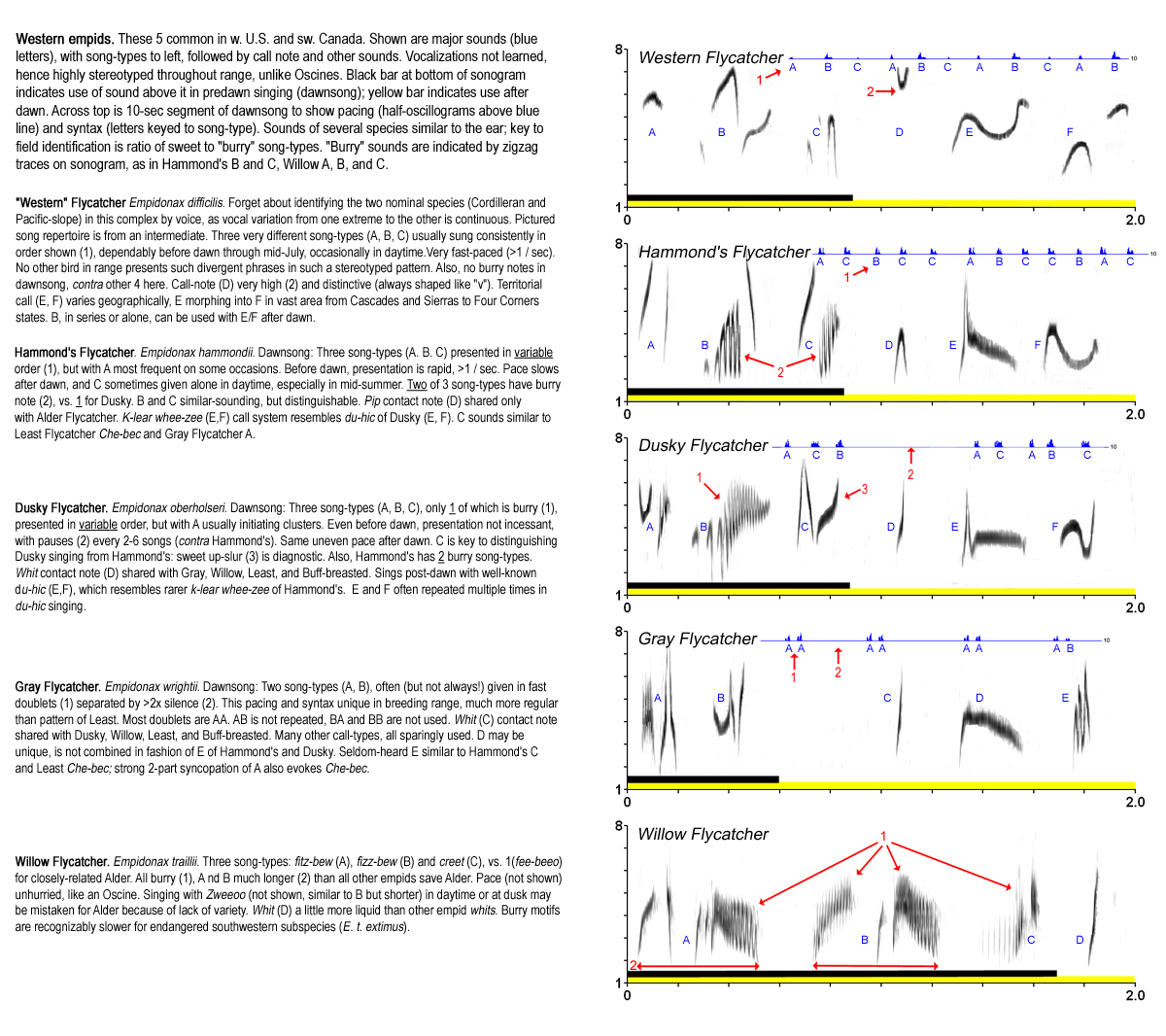
Field Guide page from article in Birding. |
Cottonwood Gulch
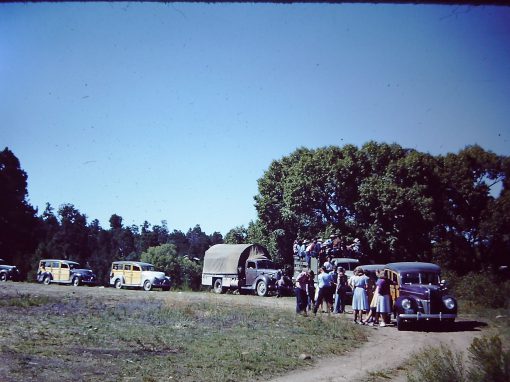
The first trek for girls, called the Turquoise Trail Expedition, rolled out in 1942. Note the "Commissary Truck" in the middle of the caravan. |
Hillis Howie led his Boy Scout troop on the first PrairieTrek from Indianapolis to the American Southwest in 1926. After exploratory trips to the Pacific Northwest and England, he settled on New Mexico, bought land for a base camp, and set up a non-profit foundation. It was named the Cottonwood Gulch Foundation, after the spring-fed cottonwoods at the base camp. I conjecture that the expedition format of the original treks was inspired by the expeditions Roy Chapman Andrews led to central Asia for the American Museum of Natural History at about the same time, and indeed Howie's early groups did collect all manner of artifacts for the Children's Museum in Indianapolis. Collecting is now known to be best left to professionals, but trek groups still mount expeditions that explore landscapes -- geophysical, ecological, social, and personal. Over the last 90+ years, thousands of young people from the U.S. and around the world have been drawn to this program and its special blend of fun and learning. They keep coming back, and many remain devoted alumni for life.
The Flocks and Rocks Trek
Cottonwood Gulch has always focused on young people, but there is no reason that adults wouldn't benefit from a few days in the out-of-doors, sleeping in a tent or under the stars, and learning about the world around them in the time-honored Gulch Way. To address this opportunity, Executive Director Kris Salisbury invited John Bloch and me to inaugurate the Flocks and Rocks Trek in 2017. We did it; it was a 9-day natural history trek for adults, with a focus on geology and ornithology. At John's urging, we followed the Rio Grande Rift from Albuquerque to the San Luis Valley, then the Jemez Lineament out to El Malpais, near the Base Camp at Cottonwood Gulch. We saw every kind of igneous rock you can imagine, and many birds, including a pair of Peregrine Falcons on a cliff in Bandelier National Monument, and an American Dipper nest by a waterfall in Colorado. Our chef, Paul Meeker, observed that we had two university-level field schools going at once. John and I did share a lot, and the participants soaked it up. They were all highly-educated, inquisitive folk who just happened to be experts in fields other than flocks and rocks. A diary of our trip is here, and a spreadsheet of our birding data may be downloaded here. In that spreadsheet, go to the Table of All Sightings to see how many birds of each species were reported on each Ebird checklist. The total was 85 species. Or go to the Downloads Page for data pertinent to all my Cottonwood Gulch treks.
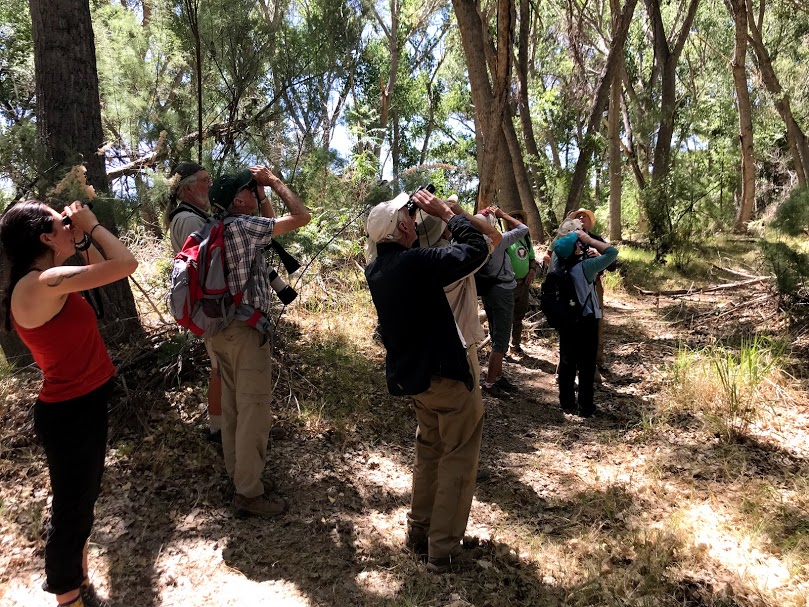
Looking up for Rose-throated Becards along the De Anza Trail. |
In 2018 the focus was more ecological, featuring the geographically unusual birds of the borderlands south of I-10 in southeastern Arizona.
That area is rampant with geology as well, and it is very different from the Rio Grande Rift. All five participants from 2017 returned, and we added 10 more.
From Organ Pipe Cactus National Monument in the west to the Chiricahua Mountains near the New Mexico border, and from the Sonoran Desert to the
high pines of Rustler Park, we saw 127 species of birds. Geology varied from a Pleistocene impact horizon to PreCambrian granite and finished with the awesome formations of Kartchner Caverns.
My plan of action for birding in 2018 is here, and a report of the outcome is
here, with the raw data
here.
The focus returned to geology in 2019 with a trip to Southwestern Utah. Everywhere we went -- Valley of Fire State Park in Nevada, Snow Canyon State Park in Utah, and Zion, Bryce, and Capitol Reef National Parks -- featured stunning and picturesque cliffs and canyon. The birding was excellent along the Virgin River and at Valley of Fire, and we even saw two massive Bighorn rams trot across the road right in front of our idling vehicles.
In 2020 we are going to take a truly unique trip, around the "Leopold Loop." Aldo Leopold, the influential conservationist and environmental philosopher, spent the early years of his career with the Forest Service in the Southwest. We we will visit places he knew well and wrote about movingly -- the Blue River, Escudilla Mountain, the White Mountains -- in an effort to honor his pioneering impact on environmental awareness in America. Jack Oviatt, Ph.D., former chair of the Geology Department at Kansas State University, will be our geologist, with John Bloch taking a break. Jack is wondering if Escudilla was glaciated. I am wondering if we can find Canada Jays and Pine Grosbeaks in the White Mountains.
In 2020 we are going to take a truly unique trip, around the "Leopold Loop." Aldo Leopold, the influential conservationist and environmental philosopher, spent the early years of his career with the Forest Service in the Southwest. We we will visit places he knew well and wrote about movingly -- the Blue River, Escudilla Mountain, the White Mountains -- in an effort to honor his pioneering impact on environmental awareness in America. Jack Oviatt, Ph.D., former chair of the Geology Department at Kansas State University, will be our geologist, with John Bloch taking a break. Jack is wondering if Escudilla was glaciated. I am wondering if we can find Canada Jays and Pine Grosbeaks in the White Mountains.
Here's What We're Planning for Flocks and Rocks 2020,
from the
Cottonwood Gulch website, with a few pictures thrown in for emphasis.
|
This adventure will begin at the Albuquerque NM Airport and venture southwest into the White Mountains of Arizona, Aldo Leopold's first duty station with the U.S. Forest Service, and the inspiration for some of the most poignant images in his classic A Sand County Almanac. The White Mountains are volcanic in origin, as befits their locations along the Jemez lineament, but to get to them we must journey down the Rio Grande rift for 70 miles on Day 1. Both the rift and the lineament are familiar to some of us from our 2017 trek. These very disparate geologic features produce plenty of habitat diversity, which gives us an immense variety of plants and animals to meet. We spend our first two nights in Water Canyon, a well-watered gash in the back side of a fault block mountain range (the Magdalenas) created when the Rio Grande rift subsided 22,000 feet in the Tertiary. We'll spend the cool morning hours of Day 2 exploring wetlands and desert at Bosque Del Apache National Wildlife Refuge, and then we'll find more cool air by driving to the top of the Magdalenas in the afternoon. Day 3 takes us 150 miles west along US 60 (an "ocean to ocean" highway), past the Sawtooth Mountains and aptly name Pie Town to the center of Leopold's Arizona world, Escudilla Mountain. We'll note the remains of the fire-ravaged spruce-fir forest on the mountain slopes and camp in the luxurious grassland on the "loop" road 56, about 1000 ft below and three miles south of the summit of Escudilla Mountain. The springs there will fuel a chorus of frogs, and perhaps rails, as we get used to the brightest starscape we have ever seen. We'll read about the grizzly who once roamed this mountain and how it inspired Leopold's classic essay "Thinking Like a Mountain," a paean to his Land Ethic. The next day those unbothered by the thin air at 9,000 feet can ascend the three miles to the fire look-out and share the panoramic views. Day 5 will take us to nearby Springerville for provisions and up into the White Mountains for a look at the vast subalpine grasslands that inspired Leopold's essay "On Top." Perhaps we'll find Frijole Cienega or "the boneyard." Then we'll return to "civilization" at Alpine and drive a few miles south to Hannagan Meadow, another spruce-fir site. From the campground one can look west onto the fire-ravaged slopes of the Black River drainage. Not far to the east is the Blue River drainage, into which we descend on Day 6. The contrast is dramatic. Hannagan could be in Colorado. Down below, Blue River Crossing is a northern extension of the canyon ecosystem of southeastern Arizona. The whole area is an Arizona Important Bird Area. We'll look for Common Black Hawks there, and drive down the canyon as far as we can get, looking for coatis and imagining the wolf restoration that would have made Leopold glad, but was vigorously resisted by local ranchers. On Day 8 we head homeward, stopping in the Plains of San Agustin to view Pleistocene lake shores and to visit the otherworldly Very Large Array. We spend that night at Water Canyon again, before our short early-morning drive to the ABQ airport on Day 9. |
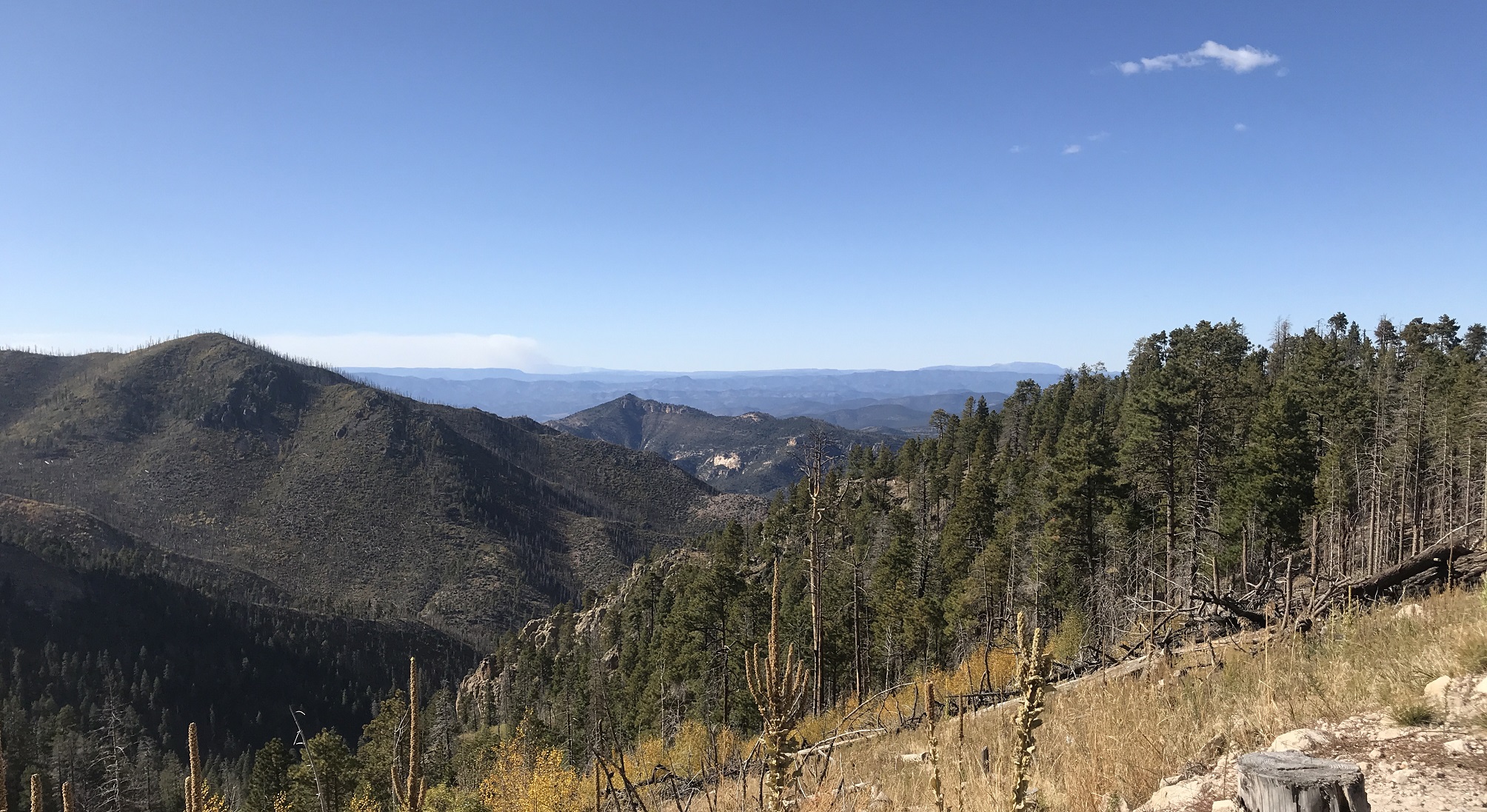
Looking from the edge of the Gila Wilderness toward the White Mountains. The smoke is from a controlled burn near Mt. Baldy. Escudilla Mountain is the high point at far right on the horizon. 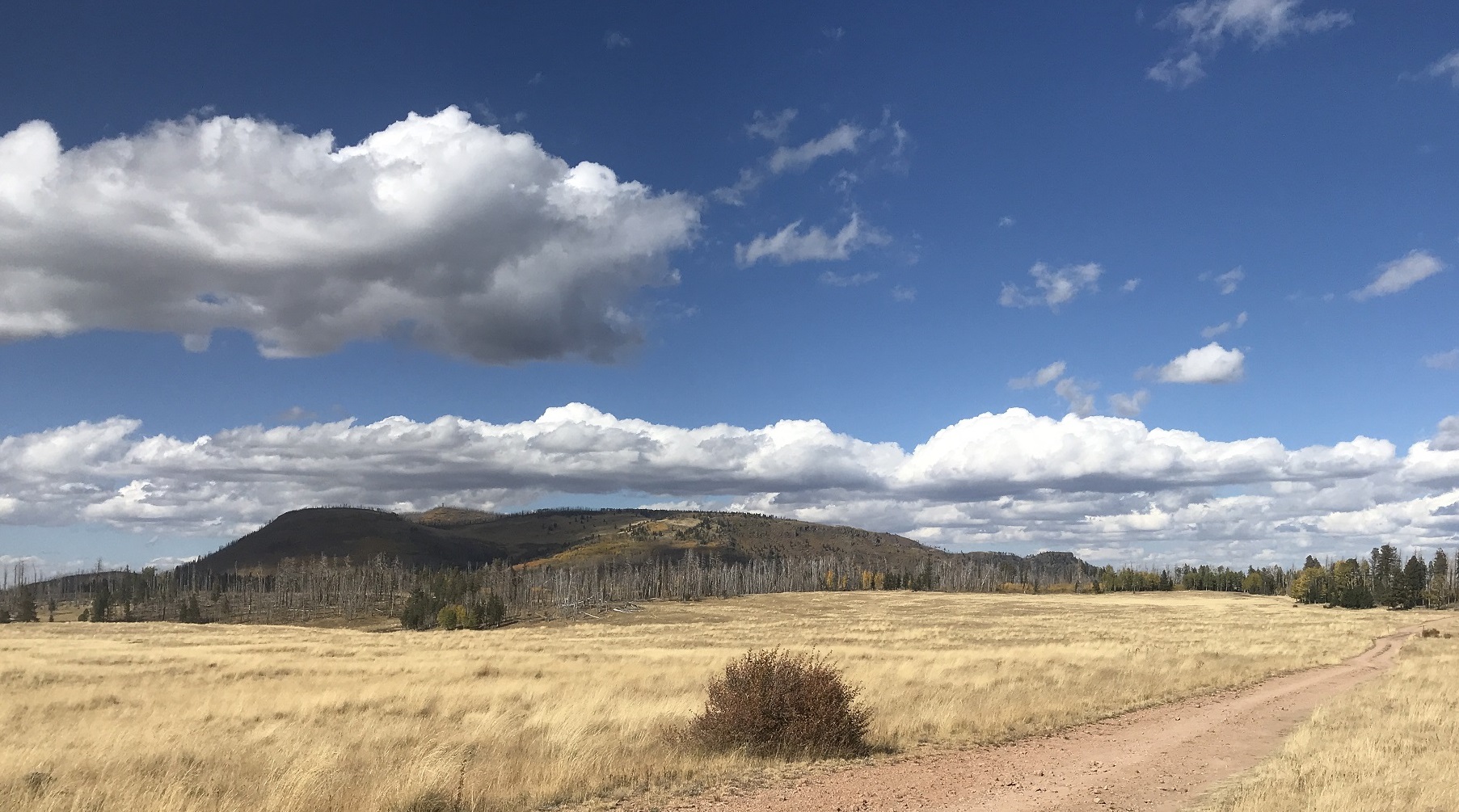
The summit of Escudilla Mountain, as seen from the Terry Loop, where we will camp, within earshot of Profanity Tank, at the interface of the luxuriant subalpoine grasslands and the spruce-fir forest. 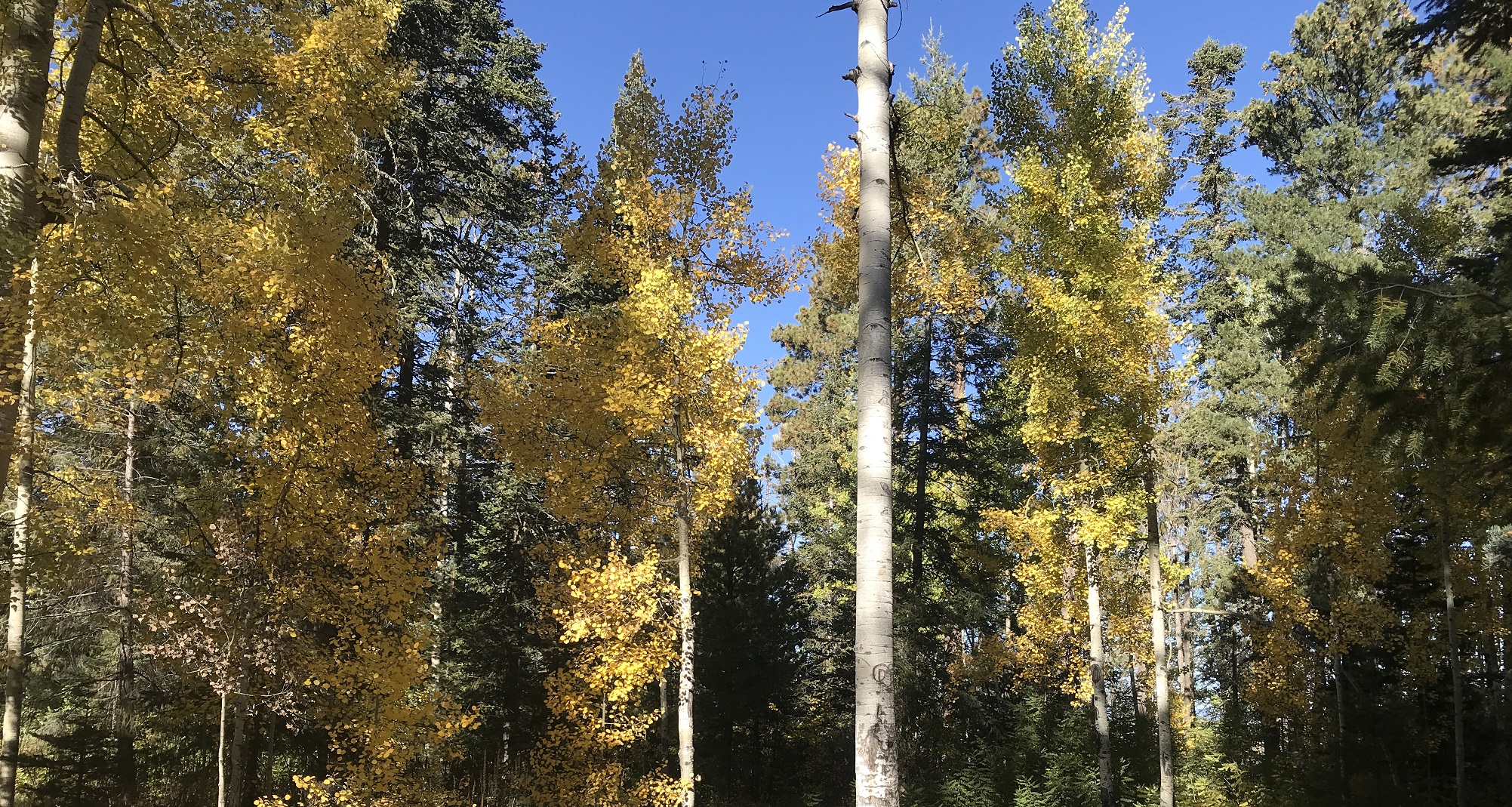
One of our stops will be at Hannagan Meadows Campground, where perhaps we will be visited by "camp robbers" aka Canada Jays, members of an isolated population on an evolutionary island. 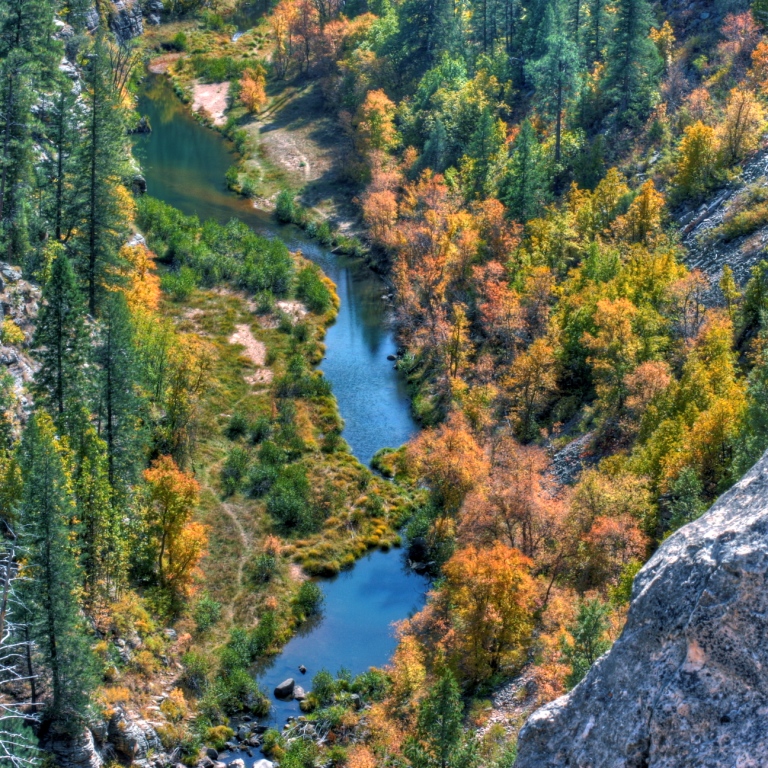
When we visit the Blue River IBA in June, the vegetation will be lush and the birds abundant and conspicuous. |
The Bird Trek
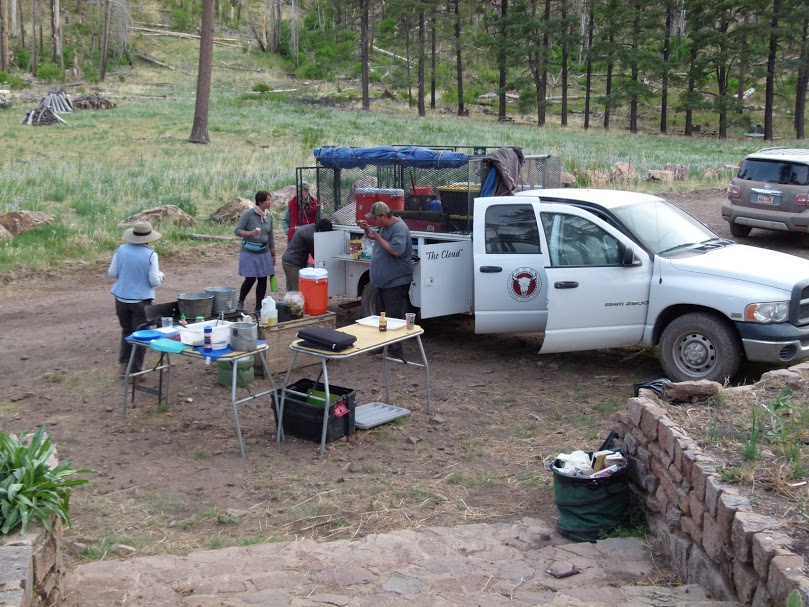
The Latest in Commissary Trucks |
Cottonwood Gulch Bird Treks fuse the logistics of Cottonwood Gulch treks with the content focus of conventional birding tours. Unlike birding tours, which use hotels and restaurants, we take everything with us, including a cook and his kitchen, and unlike Cottonwood Gulch treks we do a deep dive on one subject, birding, rather than a broad sample of natural and cultural history. The advantages of this fusion for birders are two-fold: (1) A Bird Trek is about $1000 cheaper than a birding tour, and (2), because we camp out we get a lot more exposure to the birds, especially the night birds, as we are with them 24-7. We still try to maximize creature comforts. If possible we will use a campground with showers. Our brand new cots that sit six inches off the ground fit nicely into the tents. Both are part of the package, and you can even rent a sleeping bag rather than bring your own.
In 2018 Flocks and Rocks went to southeastern Arizona, and focused on birds. We saw 127 species of birds in a week, while learning a lot of geology, yet still having time to sit around and chat. That's when I got the idea of a spin-off, an annual birding trek to this bird-rich area that would blend my love of ornithology and ecology with my appetite for finding little-known species in their specialized habitats. We might even work a little bio-acoustics into the mix. The eventual goal is to offer two back-to-back Bird Treks. Bird Trek Arizona 1.0 will focus on the species that are restricted to that area but are easy enough to find with a guide book. Of course it does increase efficiency to have a leader who has seen them before and knows some of their vocalizations. Bird Trek Arizona 2.0 will focus on species that are very rare, either because their habitat is very rare, such as Buff-collared Nightjar, or because they are just beginning to establish themselves in the United States, such as the Tufted Flycatcher.
For this first year (2020) we will begin with a turbo-charged BTA 1.0, which will take you to see and hear Elegant Trogons, Flammulated Owls
(an old specialty of mine), Mexican Chickadees, half a dozen species of hummingbirds,
Greater Pewees, Tropical Kingbirds, Gray Hawks, and a slew of other species that one must come to the Deep Southwest to find. We will also try to find
a few of the specialties that are the bailiwick of BTA 2.0. Along the way I will present chalk-talks
on the ecology of the region and the
nitty-gritty of range expansion. If you ask, I will
explain why bird names change so often, how the revolution in molecular biology has revolutionized our understanding of the genealogy of birds,
why female Black-chinned and Ruby-throated Hummingbirds are identical but the males aren't, and a few dozen other stories from my years of teaching
college-level ornithology. Bird Trek Arizona 1.0 starts
at the Tucson Airport on Saturday, May 16, 2020, and ends there on Sunday, May 24, 2020. You can sign up now by following the link above. You can also
get a lot more information about the trek on that page. If you have a question for me, send your email to birdtrek at archmccallum.com.
Here's What We're Planning for Bird Trek Arizona 2020,
from the
Cottonwood Gulch website, with a few pictures thrown in for emphasis:
|
This trek explores the mountain islands and desert seas of southeastern Arizona at a time of maximal bird activity, just before the summer heat sets in. After meeting up at the Tucson airport we will set up camp in the saguaros of Tucson Mountain Park, where we will meet the common birds of the Sonoran Desert while enjoying afternoon libations and hors d'oeuvres. The next morning we will comb the desert for Rufous-winged Sparrows and Elf Owl nests while checking off the rest of the desert specialties. We'll also hop into the vehicles, if necessary, for a quick trip to a known Harris's Hawk territory. After lunch we will visit the Arizona-Sonora Desert Museum, whose outstanding exhibits will explain desert ecology to us. They also have a number of live animal exhibits, including a hummingbird enclosure in which Costa's Hummingbirds will be nesting. For supper we will pack a picnic and ascend into the pines of Mt. Lemmon to see the only Mountain Chickadees of our trip. We'll wait around for the Flammulated Owls to start hooting before returning to camp and the Elf Owl chorus. On day 3 (May 6) we will drive 180 miles to Portal, gateway to the enchanted Chiricahua Mountains. We'll stop for lunch in Texas Canyon, whose enormous granite boulders will remind us of the 1950s westerns they played a role in. East of there we will begin to see Chihuahuan Ravens and their nests on power poles. We'll roll into Cave Creek Canyon in mid-afternoon and set up camp for a two-night stand. While supper is being prepared, we'll meet Mexican Jay, Bridled Titmouse, Acorn Woodpecker, and a host of other species that are characteristic of the wooded canyons of southeastern Arizona and Mexico. Screech-owls may serenade us at this site. The next day will be a full one, with an optional pre-breakfast trip into the desert for the dawn chorus, a morning hike (2 miles round-trip) up South Fork for Elegant Trogon and Arizona Woodpecker (and Apache Fox Squirrel), and an afternoon visit to the feeders at the Portal Store and elsewhere in Portal. On day 5 (May 8) we will break camp and take the Paradise "shortcut" (looking for Juniper Titmouse and Black-chinned Sparrow) to the feeders at the Southwestern Research Station. Then we make the short ascent to Rustler Park Campground, where the new specialty birds are Mexican Chickadee, Red-faced Warbler, Olive Warbler, Greater Pewee, and, after dark, Mexican Whip-poor-will. Some of the House Wrens are of the "brown-throated"variety, which some authorities regard as a separate species. We'll also add such common Rocky Mountain species as Pygmy Nuthatch, Broad-tailed Hummingbird, and Cordilleran Flycatcher to our lists. On day 6 we move to the Huachuca Mountains (100 miles), but we will stop by Chiricahua National Monument on the way for a look at the strange rock formations, and the many Canyon Wrens that inhabit them. If 2019's Five-striped Sparrow has returned to Guindani Canyon near Kartchner Caverns State Park, we will stop there and try for him as well. We camp that night at Reef Townsite Campground, sure to have lots of Buff-breasted Flycatchers, with the extra-limital Tufted Flycatcher a possibility. We'll have an incredible view of the desert lowlands from this 7200-foot precipice, and may hear Mountain Pygmy-Owl at dusk and dawn. Early on day 7 we descend from the Reef for a morning at the famous Ramsey Canyon Preserve. Individuals can sit and watch feeders, or take a short hike up the canyon under the towering sycamores. Let's hope that the pair of Tufted Flycatchers we saw in 2018 will be back to inspire the longer hike up their neck of the woods. In the afternoon we move on to Patagonia (50 miles). After a quick stop at the Roadside Rest for our first chance of Varied Bunting (we may be too early for them) and Thick-billed Kingbird, we'll stop by the Paton Hummer Preserve and have up-close looks at Gambel's Quails and White-winged Doves under the feeders, as well as Violet-crowned and Broad-billed Hummingbirds. We move on to Patagonia Lake State Park, where we camp in luxury, with a lake and hot showers at our disposal. We'll see if the Rufous-winged Sparrow is still defending the bath-house, and comb the lakeshore for White-faced Ibis, Neotropic Cormorant, and Mexican Duck, along with better known waterbirds. We will also hope for a return of the pair of rare Black-capped Gnatcatchers that nested successfully in 2019. For life-listers, our last day may be the most productive. We will make an early-morning trip to de Anza Trail, which runs through the luxuriant cottonwood bosque of the Santa Cruz River. We should encounter Gray Hawk, Northern Beardless Tyrannulet, Thick-billed and Tropical Kingbirds, and possibly Rose-throated Becard, Sinaloa Wren, and Rufous-backed Robin. The afternoon will be mop-up time. We will go wherever we need to in the Nogales-Patagonia area to pick up species we have missed, including a sewage plant (for whistling-ducks), the Roadside Rest, Paton's, and Blue Heaven Road. The next morning we pack up, take the short drive to the Tucson airport, and say good-bye. If interest is high, though, an extension to look for ultra-rarities may be arrangeable. Buff-collared Nightjar, anyone? |
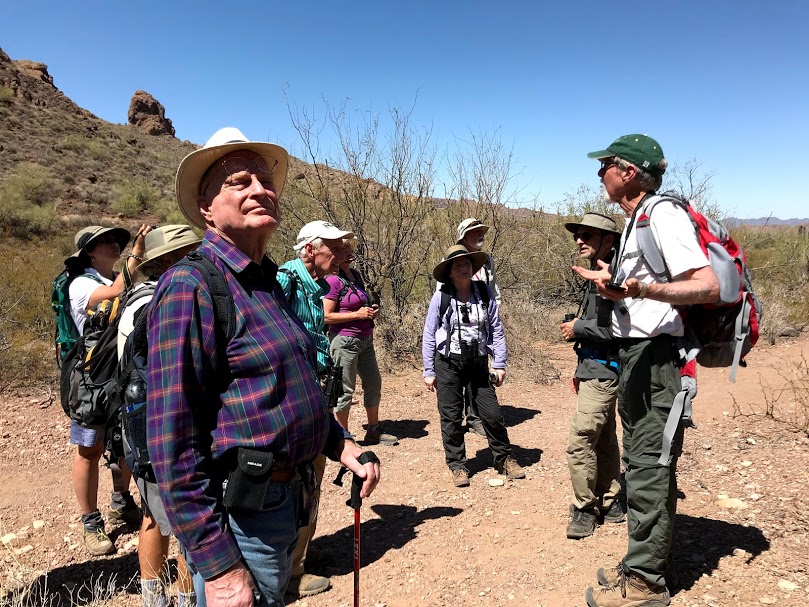
We will visit four major habitat-types: (1) Desert, home of the Elf Owl and Gilded Flicker. 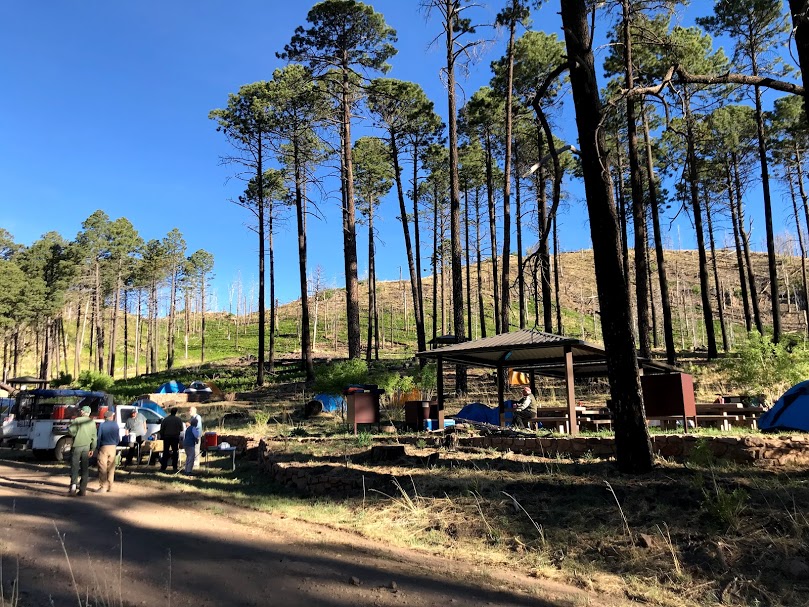
We will visit four major habitat-types: (2) Montane Conifer Forest, home of the Mexican Chickadee and Red-faced Warbler. 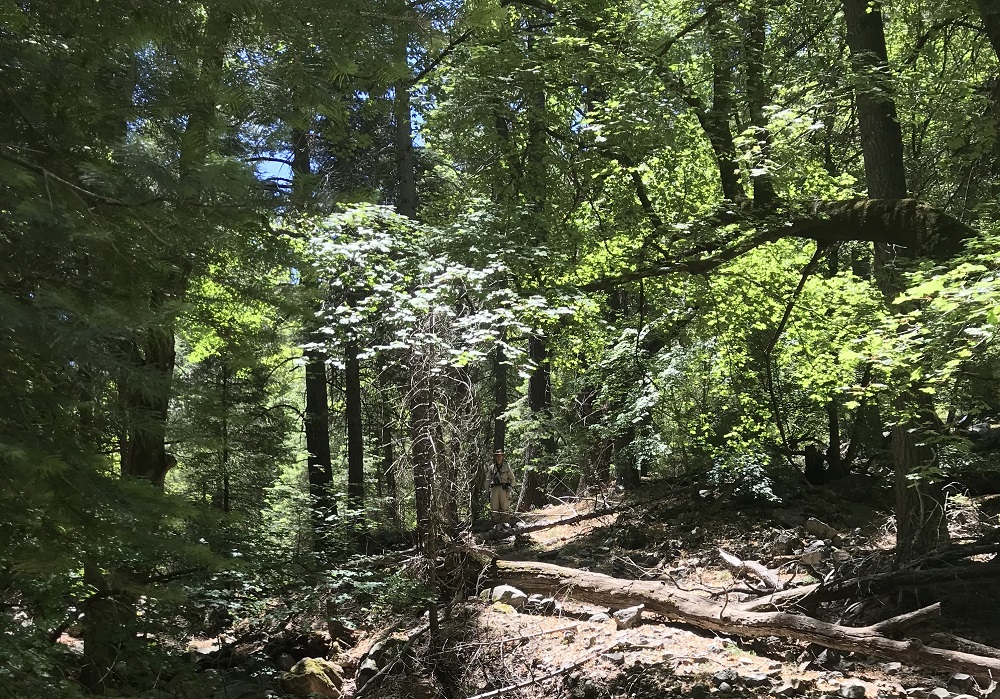
We will visit four major habitat-types: (3) Canyon Woodland, home of the Elegant Trogon and Arizona Woodpecker. 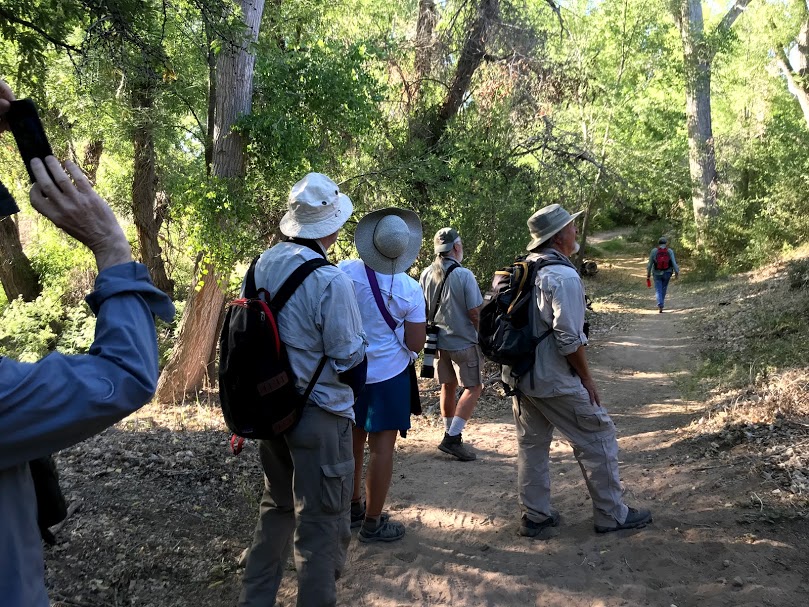
We will visit four major habitat-types: 4) Riparian Gallery Forest, home of the Rose-throated Becard and Gray Hawk. |